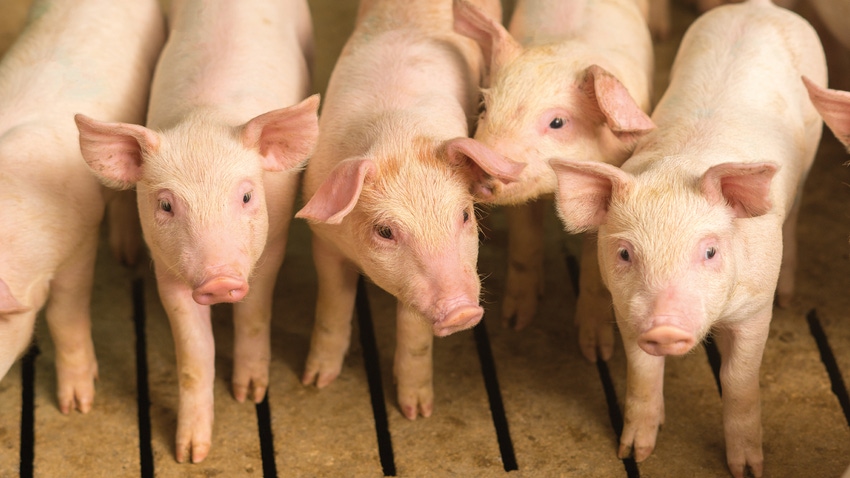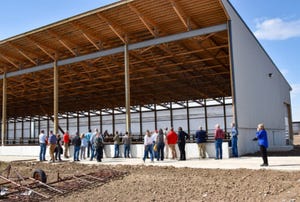Soybean meal can mitigate respiratory disease impact on pig performance
Research reveals health benefits when soybean meal is fed at higher levels due to an abundance of functional bioactive molecules in soybean meal.
February 21, 2024

Soybean meal (SBM) has long played a role in swine diets as an efficient amino acid and energy source. Increasingly, research is revealing its health-boosting properties due to an abundance of functional molecules and bioactive peptides that occur during digestion. R. Dean Boyd, PhD, Animal Nutrition Research, LLC, was involved in the first study (2010) that illustrated the positive effects of SBM on growing pigs encountering swine respiratory disease (SRD) complex. The research continues and he offers additional insights here.
How did you discover the disease-mitigating effects of SBM in pigs?
During a research project evaluating low-SBM (typical) and high-SBM (38% to 50%) diets on growing pigs, the animals encountered an active SRD infection, consisting of porcine reproductive and respiratory syndrome virus (PRRSv), influenza and Mycoplasma hyopneumoniae (Mhp). SRD triggers systemic inflammation and causes average daily gain (ADG) and feed conversion rate (FCR) to plummet.
We elected to continue the study because SRD infection is common in North America from January through April when barns are closed due to cold weather. SRD also is a frequent problem for weaned pigs coming from sow farms with active PRRSv. In reality, SRD infections can be active six to seven months of the year.
What did the study reveal regarding SRD infection and SBM levels?
In the end, pigs receiving the low-SBM diet exhibited a profound loss in ADG and FCR, which is common during periods of high immune stress. The high-SBM pigs grew as if no active infection was present.
More specifically, FCR was 0.28 points and ADG was 0.17 points worse in pigs receiving the low-SBM diet compared with the high-SBM pigs. The 0.28 point spread in FCR is a key measure in estimating feed costs for unchecked respiratory disease stress. During the three-week SRD infection, the high-SBM diets improved carcass weight gain by 3.8 lbs. per pig and provided significant feed savings.
Our results were confirmed by Gene Gourley and the Swine Graphics group, who found the same effect with a different mix of SRD agents.
What did you find in terms of the financial impact?
SRD imposes significant ‘hidden’ costs in FCR loss, increases medical treatments and creates more unthrifty grower pigs. These costs are hidden because they are wrapped up in barn close-out data, but they can add $3 to $6 per pig or more to production costs.
It is important to note that we need to look deeper into the diet effect on population carcass weight and summer weight declines because that process can begin in April when heat is not yet a problem and then continue to worsen. This could be due to unchecked SRD-impaired growth. The summer weight dip is costly and could be controlled, although more research is needed.
What is different about SBM that triggers such a positive response compared to other feed ingredients?
SBM is unique because it has abundant and diverse functional bioactive molecules compared to other feedstuffs. SBM acts as a potent immune system modulator and has antioxidant properties that address acute inflammation associated with respiratory disease. This may alter the way immune cells metabolize energy and alter energy requirements.
The disease mitigation mechanisms of SBM include anti-viral, oxidation stress reduction, anti-inflammatory, improved function of existing immune cells and preserving the integrity of the intestinal barrier.
What about other nutritional considerations?
We did look at different amino acid levels, and while they are critical for muscle growth, the animal’s physiological response is to prioritize health first. Our study showed when higher lysine levels were fed to less healthy animals, FCR and ADG became worse, not better. It was the SBM that mitigated the growth suppression of SRD and improved performance.
What is the take-home message for the role of SBM during an SRD infection?
This was the first study to show that SBM can reduce immune-stress-impaired growth. We propose that SBM is a nutritional and ‘prescriptive’ ingredient during an SRD infection in a commercial production system. Prescriptive meaning that SBM is a credible, tactical option for respiratory disease mitigation in pigs.
Increasing dietary SBM above typical levels mitigates FCR and ADG loss during an SRD infection. Therefore, it’s worth considering making seasonal dietary changes to match respiratory challenges that you are seeing in a particular pig flow.
Click to read the related research paper: Soybean Meal Mitigates Respiratory Disease - Impaired Growth in Pigs.
Fully funded by the National Soybean Checkoff.
Boyd, R. D., et al. Soybean meal mitigates respiratory disease-impaired growth in pigs. Feedstuffs. October 2023. https://informamarkets.turtl.co/story/feedstuffs-october-2023/page/1
You May Also Like




